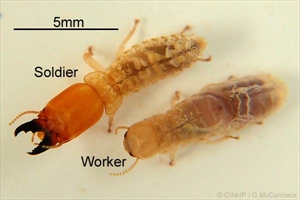Coconut termite
Pacific Pests, Pathogens and Weeds - Online edition
Pacific Pests, Pathogens & Weeds
Coconut termite (116)
Neotermes rainbowi. A related termite, Neotermes samoanus, is present in Samoa.
Oceania. It is recorded from the central Pacific. It is recorded in many atoll countries, and thought to be present in Cook Islands, Fiji (Rotuma group), and Tuvalu. Note, the presence of Neotermes rainbowi in Fiji is questioned by Waterhouse: (i) citrus and cocoa are attacked which is unusual, and (ii) the net-like grooves in the bark of coconuts are not reported. The record of Neotermes rainbowi in Tokelau and also in the Federated States of Micronesia (reported by CABI) also needs to be verified.
Coconuts mainly, but also the stilt roots of Pandanus; reports that it attacks other trees may be due to misidentifications.
Neotermes species are classified as live-wood termites, meaning they attack living trees. They are considered to be primitive termites. The life cycle starts with a nuptial flight of a winged male and female (Photo 1). A colony is established in a suitable tree, with the termites entering through a crack or wound, or chewing their way in.
After mating, the female starts laying eggs, which mostly become workers, and a few soldiers (Photo 2). These feed and tend the king and queen, more eggs are laid and the colony grows. Colonies may last for more than 20 years. Kings and queens can be replaced by immatures should they be injured or die.
The function of the grooves (Photos 3&4) in the coconut bark is unknown, but several possibilities are suggested: moisture control, temperature regulation or conditioning of the wood beneath.
The termites hollow out living trunks, leading to the top of the palm snapping off, even in the relatively low force of the trade winds. The yield of young palms may also be reduced, and they may be killed before they bear coconuts. The termite workers make holes and grooves on the surface of coconuts that are characteristic of Neotermes rainbowi and unlike other species; later, these form a net-like pattern from soil level to several metres. The grooves, which extend to the depth of the bark are covered with chips of wood and bark mixed with faecal matter.
The insides of the trunk are also attacked, and the hollowing out that occurs leads to the tops of the palms breaking off. In some places the termites spread from the infestation through roots and soil to neighbouring palms.
In communities where coconut has high social and economic importance, this is a serious pest.
Look for the net-like grooves covered with a mix of wood and faecal matter within the bark of coconuts; these channels are characteristic for the species. Look for hollowed out stumps.
NATURAL ENEMIES
There are many natural enemies, including ants and many predatory insects, but also mites, birds, lizards, snakes, frogs, fungi, and nematodes. Mostly, they hasten the demise of already weakened colonies, and have limited potential as biological control agents. Ants are probably the most important factor preventing the spread of the termite, but it is not recommended that they are introduced to islands infested with Neotermes to reduce populations or even eliminate them. Ants are more than likely to become a greater pest than the termite.
CULTURAL CONTROL
- Remove and burn infested coconuts palms as soon as the telltale net-like grooves are seen on the bark.
RESISTANT VARIETIES
No varieties of coconuts are resistant as far as is known.
CHEMICAL CONTROL
In general, insecticides are not recommended and should not be used, especially where contamination of the water table is a possibility; arsenic, lindane, dieldrin and others, which are now banned worldwide, have been used in the past.
Selected strains of Metarhizium anisopliae and an entomopathogenic nematode, Heterorhabditis sp. have been tried in Tuvalu by injecting them into termite nests and have given promising results.
____________________
When using a pesticide, always wear protective clothing and follow the instructions on the product label, such as dosage, timing of application, and pre-harvest interval. Recommendations will vary with the crop and system of cultivation. Expert advice on the most appropriate pesticides to use should always be sought from local agricultural authorities.
AUTHOR Grahame Jackson
Information from Waterhouse DF (1993) Neotermes rainbowi (Hill). Biological Control Pacific Prospects - Supplement 2. ACIAR Monograph No. 20. Brown Prior Anderson, Burwood, Victoria; and from CABI (2019) Neotermes rainbowi (coconut termite). Crop Protection Compendium. Photos 1-4 Gerald McCormak, Cook Island Biodiversity & Natural Heritage. (http://cookislands.bishopmuseum.org/).
Produced with support from the Australian Centre for International Agricultural Research under project PC/2010/090: Strengthening integrated crop management research in the Pacific Islands in support of sustainable intensification of high-value crop production, implemented by the University of Queensland and the Secretariat of the Pacific Community.







